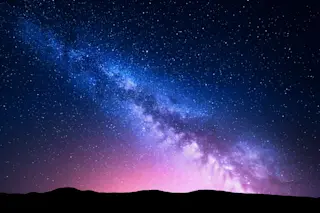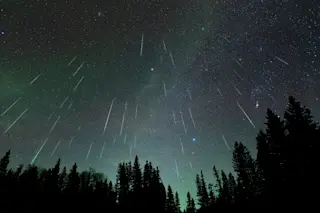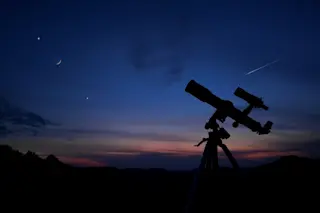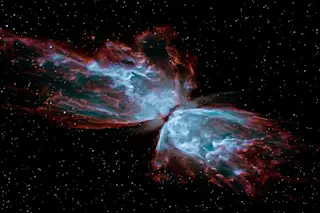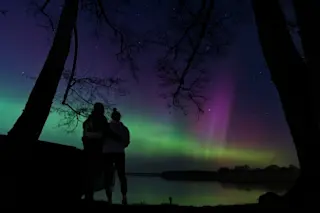The idea of a red sky at night used to invoke beautiful images of vibrant sunsets, the product of warm sunlight bathing the sky near the horizon. The adage of “red sky at night, sailor’s delight” refers to a calm night ahead; a red sunset suggests a high-pressure system in the west is bringing calm weather. But red skies at night have taken on a new meaning in recent decades. As outdoor lighting becomes increasingly prominent, our night skies are gradually turning from black to red.
This discovery came from a team of scientists led by Christopher Kyba from the Freie Universitaet and the Leibniz Institute of Freshwater Ecology and Inland Fisheries. The scientists were tracking the effects of cloud cover on light pollution when the realized the color of the night is changing. Their report, entitled “Red is the New Black,” was just published in the journal Monthly Notices of the Royal Astronomical Society.
Until relatively recently, nights skies were quite dark. The only major source of light was the Moon, allowing us to see thousands of individual stars and the wide, glowing swath of the Milky Way across the sky. Then people started illuminating the outdoors and nights became brighter. Benjamin Franklin helped promote street lamps in the U.S. and improved the designs of these early versions, which were made from candles in glass cases on top of high posts. These were replaced by gas lamps starting in Baltimore in 1816, which remained popular until Thomas Edison introduced the light bulb. Electric streetlights first appeared in Cleveland in 1879 and were the dominant form of street illumination by the turn of the century. As electricity became more affordable, the number of street lamps increased, turning dark city skies into a thing of the past.
This useful light doesn’t confine itself to the paths and streets we want to illuminate — much of it gets scattered by and into the atmosphere. This sky glow is a common phenomenon seen over busy urban areas. Some types of light fixtures produce more of a glow than others. Street lamps open on the top, unfocused lights, and upward-facing lights, like those placed under billboards, drastically increase the amount of sky glow. The more light sent upwards, the more light scattered back down by the atmosphere.
Kyba’s team sought to measure what effect cloud cover has on sky glow. In places where natural light dominates the night sky, clouds typically make those skies darker, just as they do during daylight hours. But the researchers found that the opposite is true in urban areas: Clouds actually magnify the sky glow effect by reflecting more artificial light back down to Earth. They also discovered that sky glow doesn’t just affect night time brightness — it affects the color of the sky as well.
It’s well known that the daytime sky is blue because the atmosphere scatters shorter blue wavelengths of light more than longer red wavelengths. Similarly, the team found that the shorter wavelengths of artificial light are scattered most easily on clear nights. But with cloud cover, the long-wavelength red light that is usually sent out into space on clear nights is scattered back down to Earth.
The result is that cloudy nights in urban areas have a reddish glow. And the size of the effect is substantial. Taking measurements hours every night for months in Berlin, the team found that the blue portion of sky glow is 7 times more radiant on cloudy nights than on clear night, while the red portion is 18 times brighter. In the visual range, that translates to cloudy nights being thousands of times brighter than they are in natural dark night conditions.
This has a significant effect on nature. Animals, humans included, have circadian rhythms — cyclical body clocks that regulate when we should be awake and when we should be asleep. Throw that rhythm off and you get the feeling of jet lag. Brighter nights disturb animals’ circadian rhythms and interfere with natural predator-prey relationships. (This effect is probably minor compared to other nature-unfriendly aspects of cities like heavy traffic and habitat loss.)
Kyba’s team says upcoming technological changes will soon alter how the night sky looks. The current worldwide trend is leaning towards replacing gas-discharge lamps with solid-state lighting like light-emitting diode lights. LEDs are cheaper, last longer, can turn off and on instantly, making them an ideal motion-triggered, energy-saving light source, and they can be directed to light specific areas.
The downside is that because LEDs emit more shorter wavelengths, they might make the night sky still brighter on clear nights. This increase in blue light could have an outsized effect on our circadian rhythms, which are particularly sensitive to the shorter wavelengths.
These bright nights also bring about a less concrete problem: They are taking away our beautiful night skies. The ancients knew the stars and planets with an intimate knowledge most now reserve for their favorite celebrities. A red-tinged sky with a handful of stars is far less compelling than a black night filled with innumerable points of light. Most people living in urban areas will see the Moon and a handful of stars, and if they’re lucky will get a glimpse of Venus, Mars, and Jupiter. That is, of course, assuming they know where to look. And for who know well where to look, like amateur astronomers, sky glow is of course a major annoyance.
The best solution to all these problems — maintaining natural body clocks, cutting down sky glow, and giving us back the night sky — is to change the way cities are lit. Downward-facing lights make a huge difference, and Kyba’s team recommends using “warm white” lights with as little blue wavelengths as possible. But it’s unlikely major changes will come soon. People generally like brightly lit nights, even if it means living under a red sky.
Amy Shira Teitel is a freelance space writer whose work appears regularly on Discovery News Space and Motherboard among many others. She blogs, mainly about the history of spaceflight, at Vintage Space, and tweets at @astVintageSpace.








